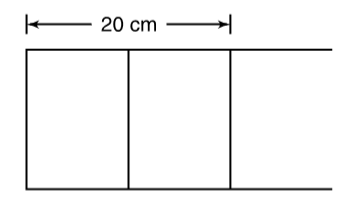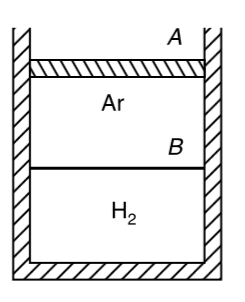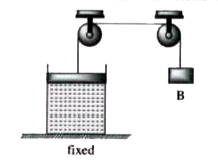A cylinder/piston contains water at 30 lbf/in.2 400 F with a volume of 1 ft3. The piston is moved slowly compressing the water to a pressure of 120 lbf/in.2. The loading on the piston is such that the product PV is a constant. Assuming that the room temperature is 70 F show that this process does not violate the second law.
C.V.: Water + cylinder out to room at 70 F
Related Solutions
A frictionless piston-cylinder based enclosure contains some amount of gas at a pressure of 400 kPa. Then heat is transferred to the gas at constant pressure in a quasi-static process. The piston moves up slowly through a height of 10 cm. If the piston has a cross-sectional area of 0.3 m^(2) , the work done by the gas in this process is
View SolutionThe pressure of a gas contained in a cylinder with a movable piston is 300 Pa. The area of the piston is . Calculate the force that is exerted on the piston.
View SolutionA gas is contained in a metallic cylinder fitted with a piston. The piston is suddenly moved in to compress the gas and is maintained at this position. As time passes the pressure of the gas in the cylinder
View SolutionA gas is contained in a metallic cylinder fitted with a piston. The piston is suddenly moved in to compress the gas and is maintained at this position. As time passes the pressure of the gas in the cylinder
View SolutionA gas is contained in a metallie cylinder fitted with a piston The piston is suddenly moved in to compress the gas and is maintained at this position. As time passes, after this pressure of the gas in the cylinder
View SolutionA frictionless piston-cylinder based enclosure contains some amount of gas at a pressure of 400kPa. Then heat is transferred to the gas at constant pressure in a quasi-static process. The piston moves up slowly through a height of 10cm. If the piston has a cross-sectional area of , the work done by the gas in this process is
View SolutionIn a cylindrical container two pistons enclose gas in two compartments as shown in the figure. The pistons have negligible thickness and can move without friction. The sys- tem is originally in equilibrium. The outer piston is slowly moved out by 10 cm and the inner piston is found to move by 4 cm. Find the distance of the inner piston in equilibrium from the closed end of the cylinder if the outer piston is slowly moved out of the cylinder. Assume temperature of the gas to remain constant.

View SolutionA pump holding water is designed as a horizontal cylinder with a piston having an area of A and an outlet orifice having an area of 'a' arranged near the cylinder axis.Determine the velocity of outflow of water in from the pump is the piston moves with a constant velocity under the action of a force F ( . Assume )
View SolutionA cylinder contains equal volumes of Ar and , separated by a freely movable piston B. Piston A can also move without friction. Volume of each gas in equilibrium is. All walls of the container including piston A are non conducting.
(i) Piston A is pushed down slowly till the volume occupied by argon becomes . Find the volume of . Assume that piston B is also non conducting.
(ii) Now assume that piston B is conducting and assume that each gas has n moles. The external agent performs work in slowly pushing down the piston A. Find rise in temperature of each gas.

View SolutionFigure shows a cylinder containing helium gas at atmospheric pressure with a tightly fitting piston of weight, one fourth the force acting due to atmospheric pressure. The cylinder is jammed at its bottom. A block B is hung by means of a massless string whose other end is attached to the piston. It is observed that the piston just starts sliding. next, the block B is directly placed above the piston. Assuming the piston to move slowly, find the fractional volume of the gas compressed

View SolutionA pump holding water is designed as a horizontal cylinder with a piston having an area of A and an outlet orifice having an area of .a. arranged near the cylinder axis. Determine the velocity of outflow of water in ms from the pump if the piston moves with a constant velocity under the action of a force F(A=2m^(2) and F=4KN . Assume A gt gt a) .
View SolutionA cylinder with a movable piston contains air under a pressure and a soap bubble of radius 'r' . The pressure to which the air should be compressed by slowly pushing the piston into the cylinder for the soap bubble to reduce its size by half will be (The surface tension is and the temperature T is maintained constant).
View SolutionA cylinder with a movable piston contains air under a pressure p_(1) and a soap bubble of radius r . The pressure p_(2) to which the air should be compressed by slowly pushing the piston into the cylinder for the soap bubble to reduce its size by half will be : (The surface tension is sigma , and the temperature T is maintained constant)
View SolutionThe pressure of a gas contained in a cylinder with a movable piston is 300 Pa. The area of the piston is 0.5 m2. Calculate the force that is exerted on the piston.
View SolutionIn a cylinder-piston arrangement air is under a pressure and constant temperature t. A soap bubble lies insie the cylinder, surface tension is T. The soap bubble is to be reduced to half its size, the required pressure to which air should be compressed by slowly pulling the piston into the cylinder is
View SolutionA vertical cylinder of height 100cm contains air at a constant temperature and its top is closed by a frictionless piston at atmospheric pressure (76 cm of Hg) as shown figure - a. If mercury is slowly poured on the piston, due to its weight air is compressed. Find the maximum height of the mercury column which can be put on the piston.

View SolutionA vertical cylinder of height 100 cm contains air at a constant temperature and its top is closed by a frictionless piston at atmospheric pressure (76 cm of Hg) asshown in figure-2.12. If mercury is slowly poured on the piston, due to its weight airis compressed. Find the maximum height of the mercury column which can be put on the piston.
View Solution100dm^3 Hydrogen is filled at 1 bar pressure in a cylinder with a moving piston. The piston is pressed until a gas of the same mass at the same temperature 2dm^3 Do not surround the volume. What will be the pressure in the cylinder?
View SolutionThe figure shows an insulated cylinder of volume V containing monoatomic gas in both the compartments. The piston is diathermic. Initially the piston is kept fixed, and the system is allowed to acquire a state of thermal equilibrium. If the initial pressures and temperatures are as shown.

Calculate the final temperature and the final pressure. Now the pin which was keeping the piston fixed is removed and the piston set free to move. The piston is allowed to slide slowly, such that a state of mechanical equilibrium is also achieved )
View SolutionA gas is filled in a cylinder fitted with a piston at a definite temperature and pressure. Explain on the basis of kinetic theory why on pulling the piston out, the pressure of decreases.
View Solution